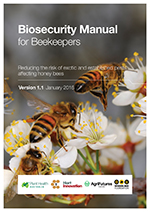
 Australia’s honey bees are some of the healthiest in the world, free from many pests and diseases found elsewhere. To help keep it that way, the manual that provides biosecurity advice to beekeepers has been updated and is now available.
Australia’s honey bees are some of the healthiest in the world, free from many pests and diseases found elsewhere. To help keep it that way, the manual that provides biosecurity advice to beekeepers has been updated and is now available.
Over recent years the number of people taking up beekeeping has increased markedly in both urban and regional areas.
Alison Saunders, National Manager Horticultural Cropping at Plant Health Australia, said that the manual includes advice about keeping honey bees healthy by controlling pests and diseases, and doing regular hive inspections.
“There are simple things that every beekeeper, whether you have one or a 1000 hives, can do to contribute to maintaining a healthy honey bee population,” said Alison.
There is also information about how to safely move hives and equipment between properties or apiaries, managing specialist products such as queen bees, packaged bees, honeycomb, and wax, and providing a pollination service for growers.
The manual now includes information about the new Biosecurity Code of Practice and the National Bee Biosecurity Program.
“The Code is being developed to incorporate fundamental biosecurity principles into the practices of all beekeepers to minimise the impact of pests and diseases on your hives and those of fellow beekeepers.”
“Most beekeepers will find keeping to the Code pretty straightforward as it is consistent with sensible management practices. Others might need to brush up on a few things but it won’t be too difficult.,” advised Alison.
 A dedicated Bee Biosecurity Officer will be available in five states (in departments of primary industry) to help implement biosecurity measures, to answer questions about beekeeping, and ensure all beekeepers are complying with the Code of Practice.
A dedicated Bee Biosecurity Officer will be available in five states (in departments of primary industry) to help implement biosecurity measures, to answer questions about beekeeping, and ensure all beekeepers are complying with the Code of Practice.
The manual also includes information about exotic and established pests and diseases of bees.
While we are still free from exotic pests such as Varroa, Tropilaelaps or tracheal mites, the effect of a new pest can be much worse if pre-existing pests and diseases like small hive beetle and American foulbrood are not being controlled.
“It is important that we are prepared for the day when any exotic pests are detected in Australia, and act quickly to minimise their impact.”
The 2012 edition of the manual was very popular, with 13,000 hard copies distributed to the members of state and territory apiarist associations. A similar number of the new edition will be distributed via state departments of primary industries and various state apiarists’ associations.